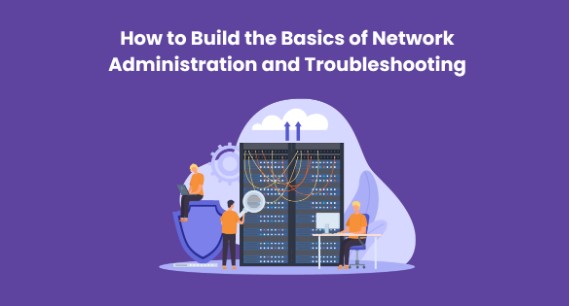Network management and troubleshooting are essential IT skills. CompTIA Course may guide IT professionals wishing to grow or newcomers keen to learn networking. These courses provide you with the skills to master network management and troubleshooting. This blog covers network administration and troubleshooting basics and how CompTIA courses may help you succeed. Explore Top CompTIA Certifications and the fundamentals you need to succeed in this sector.
Table of Contents
The Importance of Network Administration and Troubleshooting
Networks power contemporary enterprises and organisations. They provide communication, data exchange, and service integration. However, networks have obstacles. Network administrators are crucial to the dependability and security of complex systems. They manage network infrastructure, troubleshoot, and optimise performance.
The digital world is becoming more complicated, and there is an increasing need for network administrators and troubleshooters. Businesses need expertise to maintain their networks, defend them from security threats, and promptly fix difficulties. Here are the CompTIA certificates.
Top CompTIA Certifications for Network Administration and Troubleshooting
CompTIA, the Computing Technology Industry Association, provides IT industry-respected credentials. Globally recognised credentials validate your talents and expertise. These top CompTIA certifications will help you succeed in network administration and troubleshooting:
- CompTIA Network+: Beginning network administrators should start with this certification. It teaches network protocols, security, and troubleshooting. Advanced certificates built on CompTIA Network+.
- CompTIA Security+: Network management requires security. The CompTIA Security+ certification covers security fundamentals and best practices. You learn to defend networks against attacks and weaknesses.
- CompTIA A+: This certification covers hardware, software, and operating systems, not network management. IT professionals, especially network administrators, must comprehend these essentials.
- CompTIA Linux+: Many networks use Linux. You may improve your Linux server and system skills with the CompTIA Linux+ certification.
- CompTIA Cloud+: Network administrators must comprehend cloud technologies as cloud computing grows. This certification covers cloud services and infrastructure.
Building Network Administration Basics
After covering the main CompTIA certifications, let’s discuss network administrator abilities and expertise. These talents will aid your certification and network professional career.
- Understanding Network Topologies: Network managers must comprehend bus, star, ring, and mesh topologies. Designing, debugging, and growing networks requires understanding these topologies.
- Mastering IP Addressing: Networking relies on IP addressing. You should know IPv4 and IPv6. IP network configuration and troubleshooting are easier with this understanding.
- Network Protocols: Knowledge of network protocols is essential. CompTIA Network+ includes TCP/IP, DNS, DHCP, HTTP, FTP, and more. Knowing these protocols helps you fix network difficulties.
- Network Security: Any company prioritises network security. CompTIA Security+ offers a robust network security foundation. Firewalls, encryption, authentication, and network infrastructure security best practices must be understood.
- Network Troubleshooting: Network administrators need troubleshooting skills. You must quickly identify and fix network faults. Learning to utilise ping, tracers, and Wireshark may aid debugging.
- Network Monitoring: Network health depends on proactive monitoring. Software like SNMP monitors network devices and performance. Understanding these tools may help users avoid difficulties.
- Documentation: Network administrators typically underestimate the value of good documentation. Detailed network setup, modification, and problem records may save time and effort when troubleshooting or updating.
Troubleshooting Network Issues
Troubleshooting network difficulties is essential for network administrators. To troubleshoot network issues, use these steps:
- First, identify the problem. Is it a connection, network speed, or service issue?
- Gather issue information. Such as error messages, impacted devices, recent modifications, and patterns or trends.
- Focus the issue on a network component. Is it an office-specific problem or a company-wide one?
- Use ping, traceroute, and network analysers to find the problem.
- Verify network settings. Misconfigurations may disrupt the connection.
- To identify whether the problem is with the device or the network, test the problematic component with known good equipment.
- For typical network difficulties, examine network documentation and online forums, knowledge bases, and resources.
- After identifying the issue, fix it. Configuration adjustments, hardware replacement, and software upgrades may be needed.
- After fixing the problem, test the network. Also, monitor the network for recurrence.
Conclusion
In conclusion, embarking on a successful career in IT necessitates the acquisition of impeccable network administration and troubleshooting skills. Enrolling in IT Infrastructure & Networking Courses, supplemented by sought-after certifications such as CompTIA’s Network+ and Security+, lays a strong foundation for mastering these critical competencies. A thorough comprehension of network topologies, IP addresses, protocols, and adept troubleshooting techniques not only empowers you to excel in this industry but also ensures the safeguarding of vital network equipment. Given the dynamic nature of network administration, continuous learning and enhancement of skills are paramount. By investing in education and certifications, you equip yourself to navigate the intricacies of network administration and troubleshooting, setting the stage for a thriving and fulfilling career in IT.

